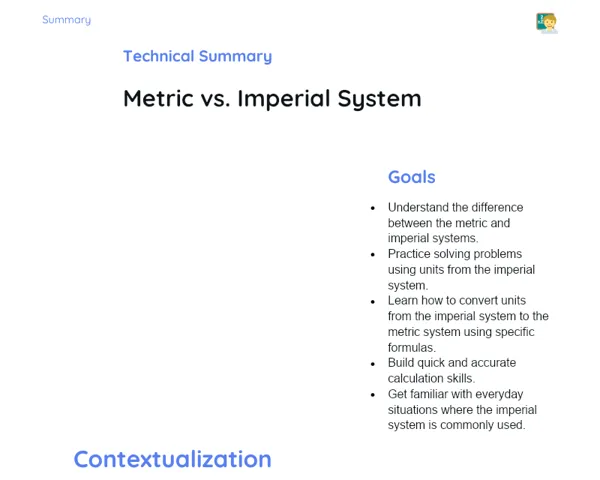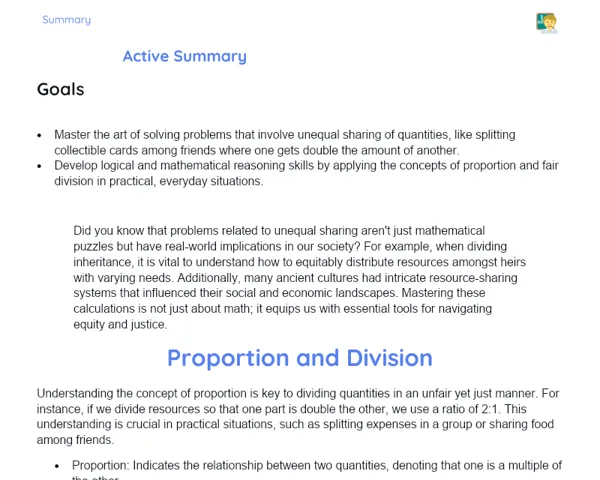Summary Tradisional | Conditional Probability
Contextualization
Conditional probability is a key concept in mathematics that helps us understand how the occurrence of one event can affect the likelihood of another happening. In simple terms, conditional probability evaluates the chance of event A occurring, given that event B has already taken place. This is represented using the notation P(A|B), which indicates the probability of A happening under the condition that B has happened.
To highlight the significance of this concept, consider a practical scenario: when diagnosing an illness, doctors frequently rely on conditional probability to assess the likelihood that a patient has a specific disease, based on certain symptoms. Similarly, in the field of artificial intelligence, conditional probability finds its use in recommendation systems, like those seen in music and movie streaming services, predicting user preferences based on their previous interactions. These examples illustrate the broad application of conditional probability across various sectors, making it a vital tool for informed decision-making.
To Remember!
Definition of Conditional Probability
Conditional probability refers to the likelihood of event A occurring, given that event B has already happened. Mathematically, it's expressed as P(A|B), where P(A|B) signifies the probability of A occurring under the knowledge that B has occurred. This concept holds great importance across various fields, as it enables us to revise the probability of an event based on additional information.
The fundamental formula for determining conditional probability is P(A|B) = P(A ∩ B) / P(B). Here, P(A ∩ B) indicates the probability of both events A and B occurring at the same time, while P(B) denotes the probability of event B. This calculation enables us to adjust the probability of A by recognizing that B has already occurred, thereby providing a clearer understanding of the situation.
Grasping conditional probability is crucial, as many events in the real world are interconnected. For instance, the probability of a patient suffering from a specific illness can significantly increase if they show certain symptoms. Consequently, conditional probability empowers healthcare professionals and others to make more informed choices based on supplementary data.
-
Conditional probability is denoted as P(A|B)
-
The formula is P(A|B) = P(A ∩ B) / P(B)
-
Essential for comprehending interconnected events
Formula of Conditional Probability
The formula for conditional probability P(A|B) = P(A ∩ B) / P(B) is vital for calculating the likelihood of an event A happening, knowing that event B has already occurred. The key to grasping this formula is to accurately interpret the terms involved: P(A ∩ B) and P(B).
P(A ∩ B) represents the probability of both events A and B happening simultaneously. This is crucial because the likelihood of A must be modified to reflect that B has already transpired. P(B) is simply the probability of event B occurring. By dividing P(A ∩ B) by P(B), we adjust the probability of A by taking this additional factor into account.
This formula is widely used in many disciplines, including statistics, computer science, and healthcare. For example, in a medical context, P(A) could represent the probability of having a particular disease, while P(B) might denote the probability of displaying a specific symptom. The formula then refines the likelihood of having the disease (A) based on the presence of the symptom (B), providing a clearer picture of conditional probability.
-
P(A ∩ B) is the probability of both events occurring
-
P(B) is the probability of event B
-
The formula revises the probability of A based on the occurrence of B
Practical Example: Urn with Colored Balls
A classic example of conditional probability involves drawing colored balls from a box. Imagine an urn filled with 3 red balls and 2 blue balls. We want to determine the chance of picking a blue ball, knowing that the first ball drawn was red.
First, we calculate the likelihood of drawing a red ball on the first attempt: P(Red1) = 3/5. Now, knowing that a red ball has been drawn, there are 4 balls remaining in the urn, consisting of 2 blue balls. The probability of drawing a blue ball on the second attempt, given that the first was red, stands at P(Blue2|Red1) = 2/4.
Thus, the conditional probability of drawing a blue ball, knowing that the first ball was red, is P(Blue2|Red1) = (3/5) * (2/4) = 3/10. This example showcases how conditional probability refines the chances of an event by considering additional information.
-
First, determine the probability of the initial event
-
Then, modify the probability of the second event based on the new information
-
A practical example to demonstrate the use of the formula
Bayes' Theorem
Bayes' Theorem serves as a significant extension of conditional probability. It provides a mechanism to update probabilities as new information emerges. The formula of Bayes' Theorem is P(A|B) = [P(B|A) * P(A)] / P(B).
In this context, P(A|B) is the probability of A occurring, given that B has occurred. P(B|A) is the probability of B occurring, given that A has happened, whereas P(A) and P(B) are the individual probabilities of events A and B, respectively. Bayes' Theorem is particularly valuable in situations requiring recalibration of our estimations as new evidence comes to light.
For instance, in the medical field, P(A) could signify the likelihood of a patient having a disease before any tests, while P(B|A) could indicate the chance of getting a positive test result, assuming the patient is already ill. By applying Bayes' Theorem, we can compute the probability that the patient has the disease after obtaining a positive test result, thereby updating our estimate based on fresh data.
-
Bayes' Theorem revises probabilities with new insights
-
The formula is P(A|B) = [P(B|A) * P(A)] / P(B)
-
Useful in scenarios where new evidence is regularly acquired
Key Terms
-
Conditional Probability: The chance of an event happening, given that another event has already transpired.
-
P(A|B): Notation for the conditional probability of A given B.
-
P(A ∩ B): Probability of both events A and B occurring.
-
Bayes' Theorem: A formula that enables the updating of probabilities based on newly acquired evidence.
-
P(B|A): Probability of B occurring, assuming A has occurred.
Important Conclusions
In this lesson, we delved into the concept of conditional probability, a fundamental topic in mathematics and various fields of study. We learned that conditional probability signifies the likelihood of event A occurring, given that event B has already transpired, utilizing the notation P(A|B) for representation. The formula P(A|B) = P(A ∩ B) / P(B) facilitates the calculation of this adjusted probability, accounting for the occurrence of event B.
We also discussed Bayes' Theorem, which further expands upon conditional probability and allows us to revise probabilities in light of new information. This theorem holds particular importance in contexts where evidence is continuously updated, such as in the medical sector and artificial intelligence. Practical examples, like drawing balls from an urn and medical diagnostics, helped elucidate how these concepts are applied in the real world.
Grasping conditional probability is vital for making informed decisions across various domains. It aids in evaluating the likelihood of events based on supplementary information, thus serving as an indispensable tool for professionals in diverse fields. We encourage you to delve deeper into the subject, as conditional probability has extensive and significant applications in our everyday lives.
Study Tips
-
Review the practical examples discussed in class and attempt to solve similar problems to strengthen your comprehension.
-
Explore additional resources, such as educational videos and textbooks, that cover conditional probability and Bayes' Theorem.
-
Practice resolving conditional probability problems in varied contexts, like everyday scenarios, healthcare, and artificial intelligence, to boost your confidence in employing these concepts.



